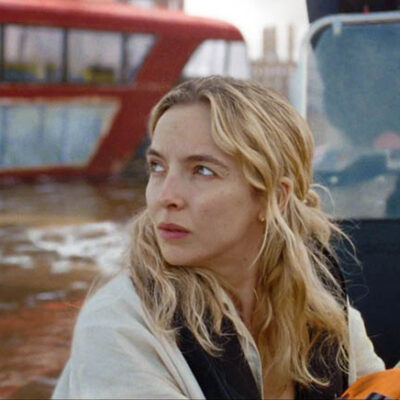By IAN FAILES

A previs’d moment in Logan’s limousine chase scene by HALON.
THE PLANT GATE BLOCKED BY THE ARMADA OF VEHICLES, Logan drives straight at the chainlink fence – and we prepare for a classic action movie fence smash.
LOGAN
Hold on!
BUT THE LIMO HITS THE FENCE, BENDS THE SUPPORTS AND GRINDS TO A PATHETIC HALT, TANGLED IN MESH. As it would in real life.
That’s an excerpt from the screenplay for Logan (story by James Mangold, screenplay by Scott Frank, James Mangold, and Michael Green). It’s a moment in the story that was fine-tuned with the help of previs. Getting the director’s vision on screen is always the goal for the actors and crew on a feature film, but it’s often the previsualization, or previs, team who gets a crack at it first.
Previs artists tend to take a script or an outline and turn it into story beats, preview imagery and breakdowns for how shots can be filmed. Occasionally, their work also informs scripted moments or generates further ideas for the director during filming (and often extends to postvis after principal photography).
Either way, the previs department has become crucial in the age of complicated visual effects and action filmmaking. VFX Voice asked three previs studios – HALON Entertainment, The Third Floor and Proof – how their artists worked at the earliest stages of production to flesh out story ideas and key moments for the films Logan, Ant-Man and the Wasp and A Wrinkle in Time.

The limo reverses after attempting to burst through a fence, only to have part of the fence stick to the vehicle. This was a moment ‘found’ through the previs process.
A FENCE STORY
In Logan, director James Mangold depicted the X-Men character Wolverine (played by Hugh Jackman) with much-applauded grittiness. Helping him on that character journey from early on was HALON Entertainment. One sequence in particular summed up the previs studio’s work – Logan, driving a limousine, escapes a group of adversaries with fellow mutants Charles Xavier (Patrick Stewart) and Laura (Dafne Keen). A key moment in the final film has the limo get stuck on a piece of fencing but continues to drive, something that actually came about as the previs was explored.
“In the beginning of the previs work, when interpreting the script pages, Jim asked me to showcase how un-heroic the life of Logan was,” recalls HALON Previsualization Supervisor Clint Reagan. “The script I started with had the limo driving around in circles avoiding capture, but upon seeing it play out it was not believable for Jim. He wanted something more realistic and difficult for Logan to manage. Nothing goes right for him, everything is hard and not fair. Right about this time we had lost the original location for the shoot that we had previs’d the entire sequence to. Now a new location was being sought.”

HALON also delivered postvis for the sequence where the limo is forced to slow down, and gets wrapped up in the metal and barbed wire.
So Reagan oversaw previs that could explore more options for the director, such as arranging the car so that Logan could just back out of the compound he was trapped in. This was deemed too ‘slick’ and convenient by Mangold. “In giving notes,” says Reagan, “Jim ranted about the Hollywood trope that so many conflict resolutions aren’t real enough. He said, ‘Like, when cars burst out of fences on cue as if they were not there. If you or I drove out of a fence right now outside you’d probably get caught up in it.’ Everyone listening laughed as he described the list of absurdities we all see in action movies. I liked how plainly this idea rebuffed convention, and I decided to previs it exactly as he had mocked. Jim was intrigued by the first pass and a bit surprised we took him so literally, but in the end it did exactly what we hoped it would.”
Meanwhile, the production searched for a suitable location, with the fence-crash shot now in the mind of the director. Even the script was updated to include it. “The stunt evolved in previs as we designed outward from the fence beat to account for how the rest of the scene would be affected,” describes Reagan. “At this point we didn’t have a location so we adjusted the old location by moving buildings to allow for the creative needs I had in previs.”
Eventually a new location was found, and HALON adjusted its previs shots to a matching digital version of the location. Says Reagan: “My team of animators and I went through the entire sequence again. We solved camera blocking problems, adjusted animation and added new beats to connect the scenes together. I’m told that irony reared its ugly head on the day of the shoot, and the fence fell right over. So they had to cable the car to stop it from blasting right through!”


















